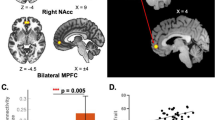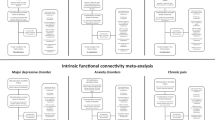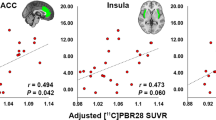Abstract
Depressive symptoms are common among individuals with chronic pain. Previous work suggests that chronic pain patients have difficulty regulating emotional responses, which is a risk factor for the development of major depressive disorder (MDD). Function of the mesocorticolimbic system, a neural network associated with reward processing, contributes to emotion regulation. This network’s dysfunction has been described in chronic pain and MDD research and potentially underlies the relationship among emotion dysregulation, chronic pain, and MDD development. Given that mood induction paradigms have been used to measure emotion regulation, the present study examined intrinsic mesocorticolimbic functional connectivity (FC) after induced sad mood in individuals with and without chronic low back pain (cLBP). Thirty-three MDD-free individuals (17 cLBP) underwent resting-state scanning before and after sad memory-evoked mood induction. A Group [cLBP, healthy control (HC)] x Mood (Neutral, Sadness) repeated measures ANCOVA was conducted on seed-based FC data using a mesolimbic a priori region of interest. Interaction effects were identified in the orbital frontal cortex and inferior frontal gyrus [F(2,29) = 21.07, pFDR < .05. hp2 = .5]. Whereas cLBP showed significantly greater FC between these two regions and the mesolimbic seed under neutral mood, FC among these regions increased in HC and decreased in cLBP under sad mood. Exploratory graph theory analyses further describe between-group differences in mesocorticolimbic network properties. Findings support previous literature describing mesocorticolimbic dysfunction in cLBP and demonstrate aberrant function in emotion regulation. Mesocorticolimbic dysfunction during emotion regulation might contribute to the development of certain depressive phenotypes in chronic pain patients.




Similar content being viewed by others
References
Bair, M. J., Robinson, R. L., Katon, W., & Kroenke, K. (2003). Depression and pain comorbidity: A literature review. Archives of Internal Medicine, 163(20), 2433–2445.
Baliki, M. N., Geha, P. Y., Fields, H. L., & Vania Apkarian, A. (2010). Predicting value of pain and analgesia: Nucleus Accumbens response to noxious stimuli changes in the presence of chronic pain. Neuron, 66(1), 149–160.
Baliki, M. N., et al. (2012). Corticostriatal functional connectivity predicts transition to chronic Back pain. Nature Neuroscience, 15(8), 1117–1119. Retrieved (http://www.ncbi.nlm.nih.gov/pmc/articles/PMC3411898/). Accessed Sept 2017.
Becerra, L., & Borsook, D. (2008). Signal valence in the nucleus Accumbens to pain onset and offset. European Journal of Pain, 12(7), 866–869.
Becerra, L., Navratilova, E., Porreca, F., & Borsook, D. (2013). Analogous responses in the nucleus Accumbens and cingulate cortex to pain onset (aversion) and offset (relief) in rats and humans. Journal of Neurophysiology, 110(5), 1221–1226.
Beck, A. T., Steer, R. A., & Brown, G. K. (1996). Beck depression inventory-II. San Antonio.
Behzadi, Y., Restom, K., Liau, J., & Liu, T. T. (2007). A component based noise correction method (CompCor) for BOLD and perfusion based FMRI. NeuroImage, 37(1), 90–101. Retrieved (http://www.ncbi.nlm.nih.gov/pmc/articles/PMC2214855/). Accessed Sept 2017.
Benarroch, E. E. (2016). Involvement of the nucleus Accumbens and dopamine system in chronic pain. Neurology, 87(16), 1720–1726.
Berna, C., et al. (2010). Induction of depressed mood disrupts emotion regulation Neurocircuitry and enhances pain unpleasantness. Biological Psychiatry, 67(11), 1083–1090.
Bullmore, E., & Sporns, O. (2009). Complex brain networks: Graph theoretical analysis of structural and functional systems. Nature Reviews. Neuroscience, 10(3), 186–198.
Bullmore, E., & Sporns, O. (2012). The economy of brain network organization. Nature Reviews. Neuroscience, 13(5), 336–349.
Chai, X. J., Ofen, N., Gabrieli, J. D. E., & Whitfield-Gabrieli, S. (2014). Selective development of Anticorrelated networks in the intrinsic functional Organization of the Human Brain. Journal of Cognitive Neuroscience, 26(3), 501–513.
Chang, P.-C., et al. (2014). Role of nucleus Accumbens in neuropathic pain: Linked multi-scale evidence in the rat transitioning to neuropathic pain. PAIN®, 155(6), 1128–1139.
Clyde, Z. (2002). DeC. Williams AC. Depression and mood. New Avenues for the Prevention of Chronic Musculoskeletal Pain and Disability. Pain Research and Clinical Management (pp. 67–82). Amsterdam: Elsevier.
Compare, A., Zarbo, C., Shonin, E., Van Gordon, W., & Marconi, C. (2014). Emotional regulation and depression: A potential mediator between heart and mind. Cardiovascular Psychiatry and Neurology, 2014, 324374.
Desikan, R. S., et al. (2006). An automated labeling system for subdividing the human cerebral cortex on MRI scans into Gyral based regions of interest. Neuroimage, 31(3), 968–980.
Donofry, S. D., Roecklein, K. A., Wildes, J. E., Miller, M. A., & Erickson, K. I. (2016). Alterations in emotion generation and regulation Neurocircuitry in depression and eating disorders: A comparative review of structural and functional neuroimaging studies. Neuroscience and Biobehavioral Reviews, 68, 911–927.
Dore, B. P., et al. (2018). Negative autobiographical memory in depression reflects elevated amygdala-hippocampal reactivity and Hippocampally associated emotion regulation. Biological Psychiatry. Cognitive Neuroscience and Neuroimaging, 3(4), 358–366.
Droutman, V., Read, S. J., & Bechara, A. (2015). Revisiting the role of the insula in addiction. Trends in Cognitive Sciences, 19(7), 414–420.
Drysdale, A. T., et al. (2017). Resting-state connectivity biomarkers define neurophysiological subtypes of depression. Nature Medicine, 23(1), 28–38.
Ehring, T., Tuschen-Caffier, B., Schnülle, J., Fischer, S., & Gross, J. J. (2010). Emotion regulation and vulnerability to depression: Spontaneous versus instructed use of emotion suppression and reappraisal. Emotion, 10(4), 563–572.
Finan, P. H., & Smith, M. T. (2013). The comorbidity of insomnia, chronic pain, and depression: Dopamine as a putative mechanism. Sleep Medicine Reviews, 17(3), 173–183.
Folstein, M. F., Robins, L. N., & Helzer, J. E. (1983). The mini-mental state examination. Archives of General Psychiatry, 40(7), 812.
Geisser, M. E., Roth, R. S., & Robinson, M. E. (1997). Assessing depression among persons with chronic pain using the Center for Epidemiological Studies-Depression Scale and the Beck depression inventory: A comparative analysis. The Clinical Journal of Pain, 13(2), 163–170.
Grabenhorst, F., & Rolls, E. T. (2011). Value, pleasure and choice in the ventral prefrontal cortex. Trends in Cognitive Sciences, 15(2), 56–67.
Grecucci, A., Giorgetta, C., Bonini, N., & Sanfey, A. G. (2013). Reappraising social emotions: The role of inferior frontal gyrus, Temporo-parietal junction and insula in interpersonal emotion regulation. Frontiers in Human Neuroscience, 7, 523.
Gross, J. J. (1998). The emerging field of emotion regulation: An integrative review. Review of General Psychology, 2(3), 271.
Haber, S. N., & Knutson, B. (2010). The reward circuit: Linking primate anatomy and human imaging. Neuropsychopharmacology, 35(1), 4–26.
Hadjipavlou, G., Dunckley, P., Behrens, T. E., & Tracey, I. (2006). Determining anatomical Connectivities between cortical and brainstem pain processing regions in humans: A diffusion tensor imaging study in healthy controls. Pain, 123(1), 169–178.
Hardy, S. G. P., & Leichnetz, G. R. (1981). Frontal cortical projections to the periaqueductal gray in the rat: A retrograde and Orthograde horseradish peroxidase study. Neuroscience Letters, 23(1), 13–17.
Harrison, B. J., et al. (2008). Modulation of brain resting-state networks by sad mood induction. PLoS One, 3(3), e1794–e1794.
Heller, A. S. (2016). Cortical-subcortical interactions in depression: From animal models to human psychopathology. Frontiers in Systems Neuroscience, 10, 20.
Heshmati, M., & Russo, S. J. (2015). Anhedonia and the brain reward circuitry in depression. Current Behavioral Neuroscience Reports, 2(3), 146–153. Retrieved (http://www.ncbi.nlm.nih.gov/pmc/articles/PMC4626008/). Accessed Sept 2018.
Honey, C. J., et al. (2009). Predicting human resting-state functional connectivity from structural connectivity. Proceedings of the National Academy of Sciences, 106(6), 2035–2040.
Hou, J., et al. (2017). Review on neural correlates of emotion regulation and music: Implications for emotion dysregulation. Frontiers in Psychology, 8, 501.
Ikemoto, S. (2010). Brain reward circuitry beyond the mesolimbic dopamine system: A neurobiological theory. Neuroscience & Biobehavioral Reviews, 35(2), 129–150.
Keller, J., et al. (2013). Trait anhedonia is associated with reduced reactivity and connectivity of mesolimbic and Paralimbic reward pathways. Journal of Psychiatric Research, 47(10), 1319–1328.
Kelly, S., Lloyd, D., Nurmikko, T., & Roberts, N. (2007). Retrieving autobiographical memories of painful events activates the anterior cingulate cortex and inferior frontal gyrus. The Journal of Pain, 8(4), 307–314.
Kerns, R. D., Bayer, L. A., & Findley, J. C. (1999). Motivation and adherence in the Management of Chronic Pain. In Handbook of pain syndromes: Biopsychosocial perspectives (pp. 99–121).
Kerns, R. D., et al. (2014). Can we improve cognitive-behavioral therapy for chronic Back pain treatment engagement and adherence? A controlled trial of tailored versus standard therapy. Health Psychology : Official Journal of the Division of Health Psychology, American Psychological Association, 33(9), 938–947.
Koechlin, H., Coakley, R., Schechter, N., Werner, C., & Kossowsky, J. (2018). The role of emotion regulation in chronic pain: A systematic literature review. Journal of Psychosomatic Research, 107, 38–45. Retrieved (http://www.sciencedirect.com/science/article/pii/S0022399917309613). Accessed Sept 2018.
Kringelbach, M. L. (2005). The human orbitofrontal cortex: Linking reward to hedonic experience. Nature Reviews Neuroscience, 6(9), 691–702.
Krüger, S., Seminowicz, D., Goldapple, K., Kennedy, S. H., & Mayberg, H. S. (2003). State and trait influences on mood regulation in bipolar disorder: Blood flow differences with an acute mood challenge. Biological Psychiatry, 54(11), 1274–1283.
Kukull, W. A., et al. (1994). The mini-mental state examination score and the clinical diagnosis of dementia. Journal of Clinical Epidemiology, 47(9), 1061–1067.
Letzen, J. E., & Robinson, M. E. (2017). Negative mood influences default mode network functional connectivity in patients with chronic low Back pain: Implications for functional neuroimaging biomarkers. Pain, 158(1), 48–57.
Lichter, D. G., & Cummings, J. L. (2001). Frontal-subcortical circuits in psychiatric and neurological disorders. Guilford Press.
Liu, X., et al. (2014). Overgeneral autobiographical memory in patients with chronic pain. Pain Medicine, 15(3), 432–439 Retrieved 10.1111/pme.12355).
Ma, S. T., Abelson, J. L., Okada, G., Taylor, S. F., & Liberzon, I. (2017). Neural circuitry of emotion regulation: Effects of appraisal, attention, and cortisol administration. Cognitive, Affective, & Behavioral Neuroscience, 17(2), 437–451.
McCracken, L. M. (1997). Attention’ to pain in persons with chronic pain: A behavioral approach. Behavior Therapy, 28(2), 271–284.
Meyer, P., Karl, A., & Flor, H. (2015). Pain can produce systematic distortions of autobiographical memory. Pain Medicine, 16(5), 905–910 Retrieved (10.1111/pme.12716).
Nees, F., & Becker, S. (2017). Psychological processes in chronic pain: Influences of reward and fear learning as key mechanisms - behavioral evidence, neural circuits, and maladaptive changes. Neuroscience.
Nestler, E. J., & Carlezon, W. A. (2006). The mesolimbic dopamine reward circuit in depression. Biological Psychiatry, 59(12), 1151–1159.
Poole, H., White, S., Blake, C., Murphy, P., & Bramwell, R. (2009). Depression in chronic pain patients: Prevalence and measurement. Pain Practice, 9(3), 173–180.
Rauch, S. L., et al. (1995). A positron emission tomographic study of simple phobic symptom provocation. Archives of General Psychiatry, 52(1), 20–28.
Rayner, L., et al. (2016). Depression in patients with chronic pain attending a specialised pain treatment Centre: Prevalence and impact on health care costs. Pain, 157(7), 1472–1479 Retrieved (http://www.ncbi.nlm.nih.gov/pmc/articles/PMC4912238/).
Rubinov, M., & Sporns, O. (2010). Complex network measures of brain connectivity: Uses and interpretations. Neuroimage, 52(3), 1059–1069.
Russo, S. J., & Nestler, E. J. (2013). The brain reward circuitry in mood disorders. Nature Reviews Neuroscience, 14(9), 609–625.
Salamone, John D. et al. (2015). “Mesolimbic dopamine and the regulation of motivated behavior.” pp. 231–57 in Behavioral Neuroscience of Motivation. Springer.
Schwartz, N., et al. (2014). Decreased motivation during chronic pain requires long-term depression in the nucleus Accumbens. Science, 345(6196), 535–542.
Sheng, J., Liu, S., Wang, Y., Cui, R., & Zhang, X. (2017). The link between depression and chronic pain: Neural mechanisms in the brain. Neural Plasticity, 2017, 9724371.
Spitzer, W. O., & LeBlanc, F. E. (1987). Scientific approach to the assessment and Management of Activity-Related Spinal Disorders: A monograph for clinicians: Report of the Quebec task force on spinal disorders. Harper & Row.
Taylor, A. M. W., Becker, S., Schweinhardt, P., & Cahill, C. (2016). Mesolimbic dopamine signaling in acute and chronic pain: Implications for motivation, analgesia, and addiction. Pain, 157(6), 1194–1198.
Thomas, M. J., Malenka, R. C., & Bonci, A. (2000). Modulation of long-term depression by dopamine in the mesolimbic system. Journal of Neuroscience, 20(15), 5581–5586.
Vachon-Presseau, E., et al. (2016). The emotional brain as a predictor and amplifier of chronic pain. Journal of Dental Research., 95, 605–612.
Vendetti, M. S., & Bunge, S. A. (2014). Evolutionary and developmental changes in the lateral Frontoparietal network: A little Goes a long way for higher-level cognition. Neuron, 84(5), 906–917.
Visted, E., Vøllestad, J., Nielsen, M. B., & Schanche, E. (2018). Emotion regulation in current and remitted depression: A systematic review and meta-analysis. Frontiers in Psychology, 9, 756. Retrieved (http://www.ncbi.nlm.nih.gov/pmc/articles/PMC5968125/). Accessed Sept 2018.
Volman, S. F., et al. (2013). New insights into the specificity and plasticity of reward and aversion encoding in the mesolimbic system. Journal of Neuroscience, 33(45), 17569–17576.
Wacker, J., Dillon, D. G., & Pizzagalli, D. A. (2009). The role of the nucleus Accumbens and rostral anterior cingulate cortex in anhedonia: Integration of resting EEG, FMRI, and volumetric techniques. NeuroImage, 46(1), 327–337.
Wager, T. D., Davidson, M. L., Hughes, B. L., Lindquist, M. A., & Ochsner, K. N. (2008). Neural mechanisms of emotion regulation: Evidence for two independent prefrontal-subcortical pathways. Neuron, 59(6), 1037–1050.
Wager, T. D., et al. (2013). An FMRI-based neurologic signature of physical pain. The New England Journal of Medicine, 368(15), 1388–1397 Retrieved (http://www.pubmedcentral.nih.gov/articlerender.fcgi?artid=3691100&tool=pmcentrez&rendertype=abstract).
Wang, J., et al. (2009). Parcellation-dependent small-world brain functional networks: A resting-state FMRI study. Human Brain Mapping, 30(5), 1511–1523.
Wang, J., Zuo, X., & He, Y. (2010). Graph-based network analysis of resting-state functional MRI. Frontiers in Systems Neuroscience, 4.
Winecoff, A., Labar, K. S., Madden, D. J., Cabeza, R., & Huettel, S. A. (2011). Cognitive and neural contributors to emotion regulation in aging. Social Cognitive and Affective Neuroscience, 6(2), 165–176.
Woo, C.-W., Krishnan, A., & Wager, T. D. (2014). Cluster-extent based thresholding in FMRI analyses: Pitfalls and recommendations. Neuroimage, 91, 412–419.
Yarkoni, T., Poldrack, R. A., Nichols, T. E., Van Essen, D. C., & Wager, T. D. (2011). Large-scale automated synthesis of human functional neuroimaging data. Nature Methods, 8(8), 665–670.
Young, C. B., et al. (2016). Anhedonia and general distress show dissociable ventromedial prefrontal cortex connectivity in major depressive disorder. Translational Psychiatry, 6(5), e810. Retrieved (http://www.ncbi.nlm.nih.gov/pmc/articles/PMC5070048/). Accessed Sept 2018.
Acknowledgements
This work was supported by grants from the National Institutes of Health to MER (PI: NIH-NCCIH R01AT001424; Co-PI: NIH-NINR R01NR015314) and JEL (F31AT007898; F32HL143941).
Funding
This work was supported by grants from the National Institutes of Health to MER (PI: NIH-NCCIH R01AT001424; Co-PI: NIH-NINR R01NR015314) and JEL (F31AT007898; F32HL143941).
Author information
Authors and Affiliations
Corresponding author
Ethics declarations
Conflict of interest
All authors declare that they have no conflict of interest. All procedures were in accordance with the ethical standards of the institutional and/or national research committee and with the 1964 Helsinki declaration and its later amendments or comparable ethical standards.
Additional information
Publisher’s note
Springer Nature remains neutral with regard to jurisdictional claims in published maps and institutional affiliations.
Rights and permissions
About this article
Cite this article
Letzen, J.E., Boissoneault, J., Sevel, L.S. et al. Altered mesocorticolimbic functional connectivity in chronic low back pain patients at rest and following sad mood induction. Brain Imaging and Behavior 14, 1118–1129 (2020). https://doi.org/10.1007/s11682-019-00076-w
Published:
Issue Date:
DOI: https://doi.org/10.1007/s11682-019-00076-w




